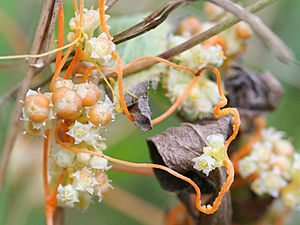Cuscuta campestris facts for kids
Quick facts for kids Cuscuta campestris |
|
|---|---|
 |
|
| Scientific classification | |
| Genus: |
Cuscuta
|
| Species: |
campestris
|
Cuscuta campestris, also known as field dodder, golden dodder, large-seeded alfalfa dodder, yellow dodder, or prairie dodder, is a special kind of plant. It's a parasitic plant, which means it gets its food from other plants instead of making its own. It belongs to the Convolvulaceae family, which also includes morning glories. In the past, it was placed in its own family called Cuscutaceae.
This plant originally comes from central North America. It attaches itself to many different kinds of plants, especially those with soft stems.
Field dodder can be a big problem for farmers. It often grows as a weed in fields of lucerne and other legumes. It has spread to many countries around the world. For example, in Australia, it is known as 'golden dodder'.
Sometimes, people have confused Cuscuta campestris with another plant called Cuscuta pentagona. However, scientists know there are clear differences between these two species. Interestingly, the tiny seeds of this plant can travel far. They have been found to be spread by water birds like ducks.
How Field Dodder Lives
Plants usually make their own food using sunlight, a process called photosynthesis. They do this with a green substance called chlorophyll. But Cuscuta plants, like field dodder, have very little or no chlorophyll. This means they cannot make their own food.
Because they can't make their own food, Cuscuta species are called holoparasitic plants. This means they completely depend on other plants, called host plants, for all their nutrients. There are about 200 known Cuscuta species, and about 10 to 15 of them are considered harmful weeds in farming.
Attaching to Host Plants
Field dodder wraps its long, thin stems around its host plants. It then grows special root-like parts called haustoria. These haustoria push into the host plant's stem. They act like tiny straws, sucking out water and nutrients from the host. This makes field dodder very hard to remove once it has attached.
When field dodder grows on crops, it can cause a lot of damage. It can lead to big losses for farmers growing alfalfa, tomatoes, carrots, and cranberries.
Life Cycle and Finding Hosts
The life of a field dodder plant begins when its seed sprouts. Young dodder seedlings cannot live for very long on their own. They must quickly find a host plant to survive. They do this by sensing special chemicals that plants release. These chemicals help the dodder seedling find the right plant stem to attach to.
Cuscuta campestris is known for slowing down the growth of its host plants. It can even stop them from flowering. This can eventually cause the host plant to die. This ability also allows dodder to control other unwanted plants, like a weed called Mikania micrantha.
Dodders also use light to find their hosts. They are strongly attracted to "far red light." This is a type of light wavelength that most plant surfaces reflect. Scientists found that dodders exposed to normal, unfiltered light could attach to a host before running out of energy. But dodders only exposed to red light often got lost. This discovery might help control dodder outbreaks. If young dodder plants are exposed to red light early on, it could stop them from spreading and growing.
See also
 In Spanish: Cuscuta campestris para niños
In Spanish: Cuscuta campestris para niños

